【探索】曲面上均匀随机采样
🗓 2019年08月16日 📁 文章归类: 0xa0_蒙特卡洛方法
版权声明:本文作者是郭飞。转载随意,标明原文链接即可。
原文链接:https://www.guofei.site/2019/08/16/random_surface.html
描述
在随机模拟实验中,在一个给定的曲面上生成均匀随机点是一个常见的需求。
但是还没发现有太好通用的算法,这里进行一些探索。
定义
我们把问题分解成两个:
- 在n维空间(n>=2)上的一条曲线上生成均匀随机点
- 在n维空间(n>=3)上的一条曲面上生成均匀随机点
何为随机?
我们已经知道 同余发生器 或者 混沌迭代式 都可以生成伪随机数,这里的随机的定义保持一致。
何为均匀随机?
我们把均匀随机定义为某种度量上的随机:
- 把曲线上的均匀随机,定义为沿着曲线的长度均匀随机采样。
- 把曲面上的均匀随机,定义为沿着曲面上的面积均匀采样。
下面这个就不能定义为均匀随机采样
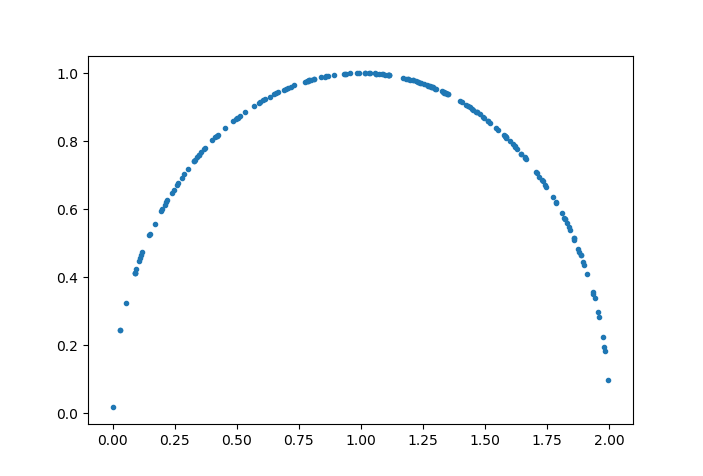
(不是我们要的结果)
为何不涉及其它维度?
因为都是已经解决的问题。
维度为1的曲线上的均匀分布,实际上就是一般说的均匀分布 np.random.rand() 已经有大量的讨论了。
维度为2的曲面上的均匀分布,实际上就是平面上某一块区域,以二维圆面为例,算法如下:
def random_surface():
while True:
x, y = np.random.rand(2) * 2 - 1
if x ** 2 + y ** 2 <= 1:
return x, y
sample = np.array([random_surface() for i in range(1000)])
plt.plot(sample[:, 0], sample[:, 1], '.')
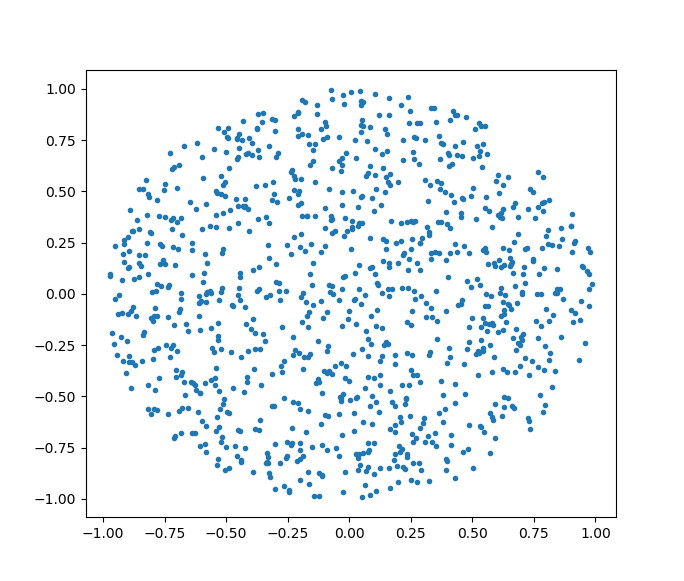
曲线上的均匀随机
假设曲线的表示是:
\(x=\phi(t),y=\psi(t), t\in [a,b]\)
第一类曲线积分 $\int_{a}^{b} ds$ 就是曲线的长度,
我们找到x,使得 $\dfrac{\int_{a}^{x} ds}{\int_{a}^{b} ds}=r$,其中$r\in[0,1]$
也就是$\dfrac{\int_{a}^{x} \sqrt{x’^2+y’^2} dt}{\int_{a}^{b} \sqrt{x’^2+y’^2} dt}=r, r\in[0,1]$
算法就是根据上面的方程,找到$x=f(r)$,然后生成随机的r,进而就找到x了。
案例:圆
$x=\cos t+1,y=\sin t, t\in [0,\pi]$
$\int_0^t ds = \int_0^t \sqrt{x’^2+y’^2} dt= t$
方程是 $t/\pi =r$
代码就有了:
def random_surface():
r = np.random.rand()
t = r * np.pi
x, y = np.cos(t) + 1, np.sin(t)
return x, y
sample = np.array([random_surface() for i in range(200)])
plt.plot(sample[:, 0], sample[:, 1], '.')
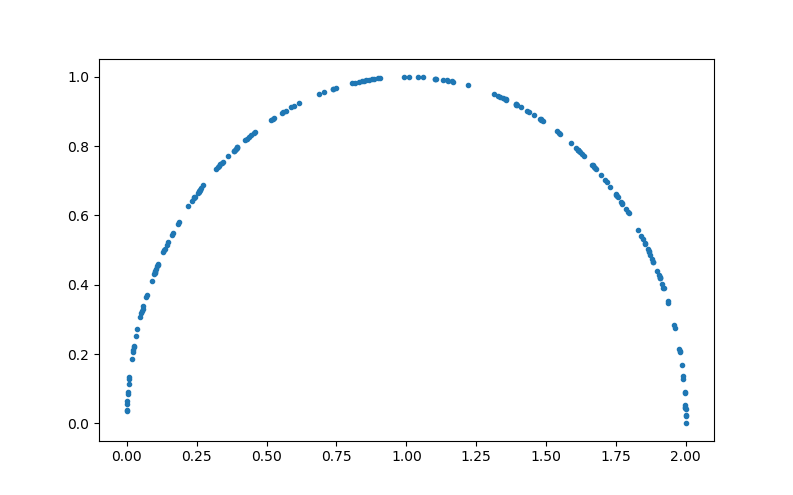
(是随机采样,所以看起来不均匀,但实际上是均匀的)
缺点与方案2
以阿基米德螺旋线$x=t\cos t, y=t\sin t$为例,
$\int_0^t ds = \int_0^t \sqrt{x’^2+y’^2} dt$
$= \int_0^t \sqrt{1+t^2}dt$
$=t/2\sqrt{1+t^2}+1/2 \ln (t+\sqrt{1+t^2})$
求积分那一步就已经有点计算量了,
解方程 $t/2\sqrt{1+t^2}+1/2 \ln (t+\sqrt{1+t^2})=r$ 更是几乎不可能。
因此必须找到一个数值方法。
import scipy.optimize as opt
import numpy as np
def func(t):
# 被积部分
return np.sqrt(1 + np.square(t))
from scipy import integrate
s, _ = integrate.quad(func, 0, 4 * np.pi) # 分母
result = []
for i in range(300):
# r = np.random.rand()
r = i / 300
t = opt.fsolve(lambda t: integrate.quad(func, 0, t)[0] / s - r, [0], fprime=func)
x = t * np.cos(t)
y = t * np.sin(t)
result.append([x, y])
result = np.array(result)
plt.plot(result[:, 0], result[:, 1], '.')
plt.show()
- 手算出被积函数的解析形式(相对来说,不很难)
- 使用了scipy的积分算法、解方程算法(因此效率会变低)
- 为了展示是否均匀,r用均匀值,而不是随机值。在实战中改成随机值。
- fprime 是雅克比矩阵,用于解方程时,加快迭代速度,可以省略。根据Lebniz定理,雅克比矩阵正好等于被积函数。
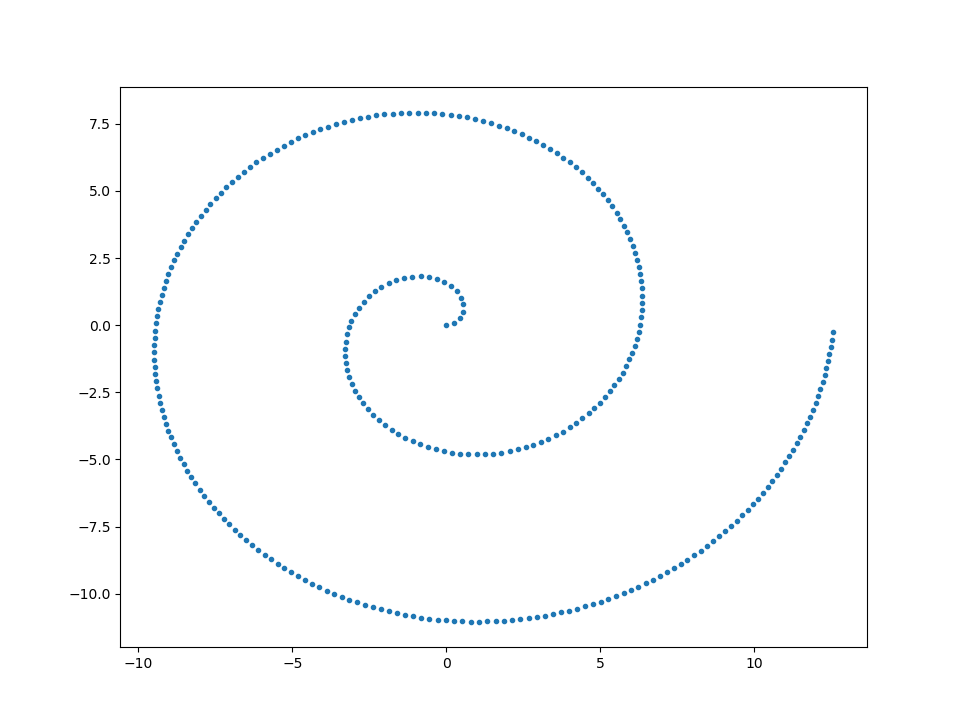
方案3
观察到这样的事实,如果把 $f(t)=\sqrt{x’^2+y’^2}$(还需要归一化) 看成一个概率密度函数,那么就可以用蒙特卡洛方法来做了。
算法步骤:
- 计算解析形式$f(t)=\sqrt{x’^2+y’^2} dt$
- 计算$m=\max f(t)$ (或者m比最大值大一些也ok)
- 在t可能的区域内随机选取一点$t$,计算$f(t)/m$
- 生成一个随机数$r\in [0,1]$,如果$f(x)/m>r$,则保留x,否则丢弃x并回到2
代码
import scipy.optimize as opt
import numpy as np
def func(t):
# 被积部分
return np.sqrt(1 + np.square(t))
left, right = 0, 4 * np.pi
m = -opt.minimize(fun=lambda t: -func(t), x0=np.array([0.1]),
method=None, jac=None,
bounds=((left, right),)).fun[0]
t_list = []
for i in range(1000):
t = np.random.rand() * (right - left) + left
if func(t) / m > np.random.rand():
t_list.append(t)
x = t_list * np.cos(t_list)
y = t_list * np.sin(t_list)
plt.plot(x, y, '.')
plt.show()
优缺点:
- 不用解积分,也不用解方程。大大提高效率
- 但是会有大量空运算(丢弃),所以当f不均匀,或者返回太大时,效率变低。不过貌似效率再低也比方案2强。
这是目前能想到的最有效的方案了。
曲面上的均匀随机
推广
回到曲线上均匀分布的推导过程,我们找到方程 $\dfrac{\int_{a}^{x} ds}{\int_{a}^{b} ds}=r$,其中$r\in[0,1]$ 的解,作为随机生成算法。
由于积分和方程难以解出,求助了数值方法去计算。
对于曲面上的情况,类似的,
$\iint_D 1d\sigma=\iint_{\Omega_{xy}}\sqrt{1+(\dfrac{\partial z}{\partial x})^2+(\dfrac{\partial z}{\partial y})^2}dxdy=r$
案例:球面
$z=\sqrt{1-x^2-y^2}$
$f(x,y)=\sqrt{1+(\dfrac{\partial z}{\partial x})^2+(\dfrac{\partial z}{\partial y})^2}=\sqrt{1/(1-x^2-y^2)}$
为了符号统一,我们把$f(x,y)$定义在$R^2$上,并且对于原本没有定义的点,定义$f(x,y)=0$
不影响积分$\int_{-\infty}^{+\infty}\int_{-\infty}^{+\infty} f(x,y)dxdy$
又记 $g(x)=\int_{-\infty}^{+\infty} f(x,y)dy$
得到$\int_{-\infty}^{x}g(x)/\int_{-\infty}^{+\infty}g(x)=r$,并求解$x=x’$
$\int_{-\infty}^{y} f(x’,y)dy/\int_{-\infty}^{+\infty} f(x’,y)dy=r’$,求解$y=y’$
之后得到$(x’,y’)$就是我们要的结果
from scipy import optimize as opt
from scipy import integrate
import numpy as np
import matplotlib.pyplot as plt
from mpl_toolkits.mplot3d import Axes3D
fig = plt.figure()
ax = fig.gca(projection='3d')
def bound(x, y):
return x ** 2 + y ** 2 <= 0.9
def func(x, y):
if bound(x, y):
return 1 / np.sqrt(1 - x ** 2 - y ** 2)
else:
return 0
x_min, x_max, y_min, y_max = -0.9, 0.9, -0.9, 0.9
def func_g(x):
g = integrate.quad(lambda y: func(x, y), -np.sqrt(1 - x ** 2), np.sqrt(1 - x ** 2))
return g[0]
# g(x)的最大值
m1 = -opt.minimize(fun=lambda x: -func_g(x), x0=np.array([0.1]),
bounds=((x_min, x_max),)).fun
# f(x,y)的最大值
# m2 = -opt.minimize(fun=lambda xy: -func(xy[0], xy[1]), x0=np.array([0.1, 0.1]),
# bounds=((x_min, x_max), (y_min, y_max))).fun
m2 = np.sqrt(10)
result = []
for i in range(1000):
x = np.random.rand() * (x_max - x_min) + x_min
if func_g(x) / m1 > np.random.rand():
not_find = True
while not_find:
y = np.random.rand() * (y_max - y_min) + y_min
if func(x, y) / m2 > np.random.rand():
result.append([x, y])
not_find = False
# 整理并绘图
result = np.array(result)
X = result[:, 0]
Y = result[:, 1]
Z = np.sqrt(1 - X ** 2 - Y ** 2)
surf = ax.scatter(X, Y, Z)
plt.show()
# %%
np.array([func_g(i) for i in np.arange(-1, 1, 0.1)])
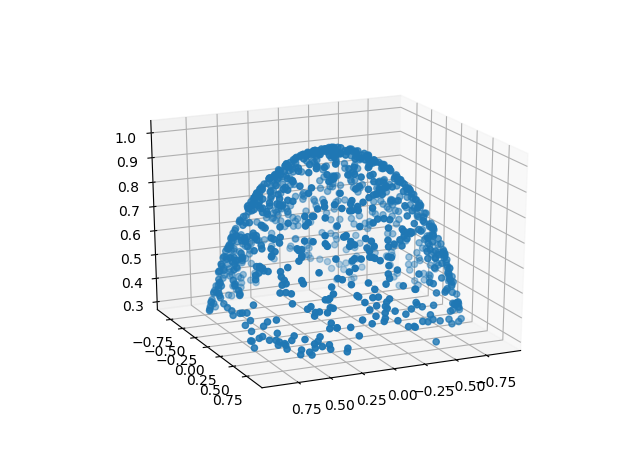
缺点与改进
上面的程序warning很多,这是因为边缘太陡峭了,导致偏导数很大。另外如果边缘陡峭,算法效率也很低,因为大多数区域内的取样大概率被剔除,然后重新取样。
为了解决这个问题,考虑把曲面方程变成参数形式(曲线线的情况就是这么干的)。
假设我们的曲面方程式这个形式 $\vec r=\vec r(u,v)$
曲面积分为 $\iint_{D}=\mid\vec r_u\times\vec r_v\mid dudv$
推导过程就不写了,直接上算法流程
- 对于通常的曲面可以(并不)轻松地找到上述参数表示形式,使得:
- $\vec r_u\times\vec r_v \neq 0$
- $u,v$的边界都是常数(而不是互相有关)
- 计算 $I(u,v)=\mid\vec r_u\times\vec r_v\mid$
- 计算 $m=\max I+\delta$(其中$\delta\geq0$可以自行制定,如果对m的计算没有信心,可以指定为一个正数,这个数如果太大,算法效率会有所降低。)
- 对$u,v$在其边界内均匀采样,并且以$I(u,v)/m$的概率丢弃这次采样结果
以球面为例$\vec r=(\sin u\cos v,\sin u\sin v,\cos u)$
import numpy as np
import scipy.optimize as opt
from scipy.misc import derivative
# 参数方程$r=r(u,v)$
def func(u, v):
x = np.sin(u) * np.cos(v)
y = np.sin(u) * np.sin(v)
z = np.cos(u)
return x, y, z
# r对u的偏导数,可以手算,这里用数值方法
def func_r_u(u, v):
return derivative(lambda u: func(u, v)[0], u), \
derivative(lambda u: func(u, v)[1], u), \
derivative(lambda u: func(u, v)[2], u)
# r对v的偏导数
def func_r_v(u, v):
return derivative(lambda v: func(u, v)[0], v), \
derivative(lambda v: func(u, v)[1], v), \
derivative(lambda v: func(u, v)[2], v)
def func_I(u, v):
r_u = func_r_u(u, v)
r_v = func_r_v(u, v)
E = np.linalg.norm(r_u, ord=2)
G = np.linalg.norm(r_v, ord=2)
F = np.dot(r_u, r_v)
return np.sqrt(E * G - F ** 2)
left, right = 0, 2 * np.pi
m = -opt.minimize(fun=lambda t: -func_I(t[0], t[1]), x0=np.array([0.1, 0.1]),
bounds=((left, right), (left, right))).fun
m = m + 0.1
# %%
points = np.random.rand(3000, 2) * np.pi * 2
result = []
for point in points:
if func_I(point[0], point[1]) / m > np.random.rand():
result.append(point)
# %%画图
import matplotlib.pyplot as plt
from mpl_toolkits.mplot3d import Axes3D
fig = plt.figure()
ax = fig.gca(projection='3d')
X, Y, Z = [], [], []
for point in result:
u, v = point
x, y, z = func(u, v)
X.append(x)
Y.append(y)
Z.append(z)
X = np.array(X)
Y = np.array(Y)
Z = np.array(Z)
surf = ax.scatter(X, Y, Z, '.')
plt.show()
优点:
- 参数的边界是方形的,用$z(x,y)$表示的球面,其x-y边界不是方形的。
- 参数可以尽量避免偏导数过大,甚至无穷大的情况
您的支持将鼓励我继续创作!
